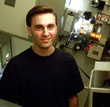|
|
This topic comprises 2 pages: 1 2
|
|
Author
|
Topic: What is a Schneider 'Cinevar'?
|
|
|
|
|
|
|
|
|
|
|
John Pytlak
Film God

Posts: 9987
From: Rochester, NY 14650-1922
Registered: Jan 2000
|
 posted 08-16-2000 06:00 AM
posted 08-16-2000 06:00 AM





John:As I noted in another post, Glenn Berggren demonstrated a 1.5X squeeze anamorphic lens called "IscoVision" in 1984. It basically used the ISCORAMA optics developed by IscoOptic. Using a 1.50X anamorphic lens with the present 0.825 x 0.690 inch "scope" image area gives an aspect ratio of 1.79:1, which is very close to today's 1.85:1 aspect ratio, and a near perfect match to the 16:9 aspect ratio of HDTV. By using a larger image area on the film, grain and sharpness are improved, and you get 1.5X more light on the screen than current "flat" 1.85:1, by simply changing the lens. For example, a theatre struggling to get 11 footlamberts for 1.85:1 would get 16 footlamberts by using the scope aperture and the new 1.5X anamorphic lens. It was a great idea, and still is! That's why I am making a presentation and showing a demonstration at the SMPTE Technical Conference in Pasadena this October, showing how it could easily be done using today's technology, including Super-35 production with new 1.5X anamorphic printing and projection lenses. Doing the 1.5X squeeze on an optical printer when making the duplicate negative has the additional advantage of "forcing" a pin registered printing step, which should greatly improve steadiness and sharpness, since it eliminates the printer "slip" issues associated with contact printing short pitch master positives to short pitch duplicate negatives. But convincing cash-starved theatre owners to buy new 1.5X anamorphic lenses costing a couple thousand dollars will be a challenge, even with advantages clearly seen on the screen by almost anyone. ------------------
John P. Pytlak, Senior Technical Specialist
Worldwide Technical Services, Entertainment Imaging
Eastman Kodak Company
Research Labs, Building 69, Room 7419
Rochester, New York, 14650-1922 USA
Tel: 716-477-5325 Fax: 716-722-7243
E-Mail: john.pytlak@kodak.com
| IP: Logged
|
|
|
|
John Walsh
Film God

Posts: 2490
From: Connecticut, USA, Earth, Milky Way
Registered: Oct 1999
|
 posted 08-16-2000 12:14 PM
posted 08-16-2000 12:14 PM




Michael: I don't mind finding stuff. It's kinda fun. When I first started learning about projection, a person was really at the mercy of whoever was training them to provide information. If they didn't know, neither did you. It's so easy now with the internet; it's no trouble.Mark is probably right; it's probably one of those smaller magnifiers. John P: I knew about Iscovision for motion pictures, but never knew they developed adapters for 35mm slide application. Not to be a crank, but I kinda feel that Iscovision is like ISDN; too little, too late. The results are of course better, but not enough to spend the money on. In addition to the cost of lenses and labor (not much, I know), what will theater owners (employing less experienced projection staff) do with lens turrets that only accept two lenses? Would the studios be willing to help with the cost of outfitting the theaters with e-projection looming?
| IP: Logged
|
|
John Pytlak
Film God

Posts: 9987
From: Rochester, NY 14650-1922
Registered: Jan 2000
|
 posted 08-16-2000 01:17 PM
posted 08-16-2000 01:17 PM





John Walsh said: "Not to be a crank, but I kinda feel that Iscovision is like ISDN; too little, too late. The results are of course better, but not enough to spend the money on. In addition to the cost of lenses and labor (not much, I know), what will theater owners (employing less experienced projection staff) do with lens turrets that only accept two lenses? Would the studios be willing to help with the cost of outfitting the theaters with e-projection looming?" I hope you're wrong. IscoVision was ready in 1984, everyone agreed the improvement was significant, but no one wanted to spend the money needed to improve quality. Today, screens are even larger (and dimmer). I hope theatre owners can see the logic of buying a new lens that gives them 1.5X more light on the screen with their current lamphouse. Doing the same thing with a lamp might mean going from a 4000 to a 5000 watt lamp, with its increased purchase and operating cost, and increased risk of film heat damage and focus flutter. For underlit screens that already are at the limit of 6000 or 7000 watt lamps, the format is about the only easy way to get more light. As far as the lens turret and automation, the new format would eventually replace the "flat" 1.85:1 format, so there would still be only two widely used formats (Scope 2X 2.39:1, and Scope 1.5X 1.79:1). Something is wrong with this picture  : Theatre executives willing to spend hundreds of thousands of dollars per screen to install Digital Cinema, when a $2,000 lens will give them a much better picture that is 50% brighter. : Theatre executives willing to spend hundreds of thousands of dollars per screen to install Digital Cinema, when a $2,000 lens will give them a much better picture that is 50% brighter. ------------------
John P. Pytlak, Senior Technical Specialist
Worldwide Technical Services, Entertainment Imaging
Eastman Kodak Company
Research Labs, Building 69, Room 7419
Rochester, New York, 14650-1922 USA
Tel: 716-477-5325 Fax: 716-722-7243
E-Mail: john.pytlak@kodak.com
| IP: Logged
|
|
|
|
Tim Killen
Film Handler
Posts: 13
From: Melbourne, Victoria, Australia
Registered: Mar 2000
|
 posted 08-16-2000 09:36 PM
posted 08-16-2000 09:36 PM




Michael,The Schnieder zooms that people are refering to are CINE XENON CONVERTERS which can adjust focal length up to approx 3.5mm from its original focal length. What you are describing though is the CINEVAR lens from Schnieder which acts the same as a Magnacom that you can get from other lens suppliers. Basically, if you use a single lens for your primary or backing lens, then in most instance its focal length is set for Cinemascope and because its focal legth will be higher than a Widescreen the Cinevar lens will reduce that focal length back down suitable for W/S presentation. These are not ideal situations as stated by Brad in an earlier thread as these types of lens will reduce focal properties and light output. Hopes this helps your question Tim Killen
| IP: Logged
|
|
|
|
Tim Killen
Film Handler
Posts: 13
From: Melbourne, Victoria, Australia
Registered: Mar 2000
|
 posted 08-17-2000 02:35 AM
posted 08-17-2000 02:35 AM




Michael,This seems a very illogical way of going about things, as stated by using a Cinevar lens it reduces focal properties and light output. Check your scope lens and you should find that the backing lens is also 65mm if this is the case you should be able to use a 32.5mm lens for W/S without the Cinevar and this should produce a much sharper picture. Hope this helps Tim Killen
| IP: Logged
|
|
|
|
|
|
|
|
All times are Central (GMT -6:00)
|
This topic comprises 2 pages: 1 2
|
Powered by Infopop Corporation
UBB.classicTM
6.3.1.2
The Film-Tech Forums are designed for various members related to the cinema industry to express their opinions, viewpoints and testimonials on various products, services and events based upon speculation, personal knowledge and factual information through use, therefore all views represented here allow no liability upon the publishers of this web site and the owners of said views assume no liability for any ill will resulting from these postings. The posts made here are for educational as well as entertainment purposes and as such anyone viewing this portion of the website must accept these views as statements of the author of that opinion
and agrees to release the authors from any and all liability.
|

 Home
Home
 Products
Products
 Store
Store
 Forum
Forum
 Warehouse
Warehouse
 Contact Us
Contact Us




 Printer-friendly view of this topic
Printer-friendly view of this topic










 : Theatre executives willing to spend hundreds of thousands of dollars per screen to install Digital Cinema, when a $2,000 lens will give them a much better picture that is 50% brighter.
: Theatre executives willing to spend hundreds of thousands of dollars per screen to install Digital Cinema, when a $2,000 lens will give them a much better picture that is 50% brighter. 



